Over the past years, we have been more and more involved in projects that have significant multimedia requirements. As part of this trend, 2020 has lead us to work on a number of contributions to the Video4Linux subsystem of the Linux kernel, with new drivers for camera interfaces, camera sensors, video decoders, and even HW-accelerated video encoding. In this blog post, we propose to summarize our contributions and their status on the following topics:
- Rockchip PX30, RK1808, RK3128 and RK3288 camera interface driver
- Allwinner A31, V3s/V3/S3 and A83T MIPI CSI-2 support for the camera interface driver
- Omnivision OV8865 camera sensor driver
- Omnivision OV5648 camera sensor driver
- TW9900 PAL/NTSC video decoder driver
- Rockchip HW-accelerated H264 video encoding
Rockchip camera interface
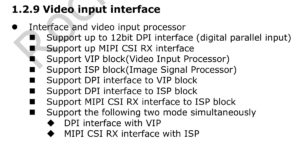 The Rockchip ARM processors are known to have very good support in the upstream Linux kernel. However, one area where the support was lacking is in the support of the camera interface used by those SoCs. And it turns out that Bootlin engineer Maxime Chevallier has worked precisely on this topic throughout 2020: the development and upstreaming of the
The Rockchip ARM processors are known to have very good support in the upstream Linux kernel. However, one area where the support was lacking is in the support of the camera interface used by those SoCs. And it turns out that Bootlin engineer Maxime Chevallier has worked precisely on this topic throughout 2020: the development and upstreaming of the rkvip driver, a Video4Linux driver for the Rockchip camera interface. While the work was done and tested on a Rockchip PX30 platform, the same camera interface is used on RK1808, RK3128 and RK3288.
Several iterations of the driver have been posted on the linux-media mailing list, with the latest iteration, version 5, posted on December 29, 2020:
Maxime Chevallier (3): media: dt-bindings: media: Document Rockchip VIP bindings media: rockchip: Introduce driver for Rockhip's camera interface arm64: dts: rockchip: Add the camera interface description of the PX30 .../bindings/media/rockchip-vip.yaml | 101 ++ arch/arm64/boot/dts/rockchip/px30.dtsi | 12 + drivers/media/platform/Kconfig | 15 + drivers/media/platform/Makefile | 1 + drivers/media/platform/rockchip/vip/Makefile | 3 + drivers/media/platform/rockchip/vip/capture.c | 1146 +++++++++++++++++ drivers/media/platform/rockchip/vip/dev.c | 331 +++++ drivers/media/platform/rockchip/vip/dev.h | 203 +++ drivers/media/platform/rockchip/vip/regs.h | 260 ++++ 9 files changed, 2072 insertions(+) create mode 100644 Documentation/devicetree/bindings/media/rockchip-vip.yaml create mode 100644 drivers/media/platform/rockchip/vip/Makefile create mode 100644 drivers/media/platform/rockchip/vip/capture.c create mode 100644 drivers/media/platform/rockchip/vip/dev.c create mode 100644 drivers/media/platform/rockchip/vip/dev.h create mode 100644 drivers/media/platform/rockchip/vip/regs.h
We’re hoping to get this driver merged soon, as we have now addressed the feedback that was received through the 5 iterations the patch series as gone through. It should be noted that for now it only supports the parallel BT656 interface as this is what we needed for our current project, we are definitely able to extend it to support MIPI CSI2 as well if you’re interested!
It should be noted that as a result of this work, Maxime Chevallier also prepared and delivered a talk From a video sensor to your display which was given at the Embedded Linux Conference Europe 2020. See the slides and video.
Allwinner MIPI CSI2 camera interface
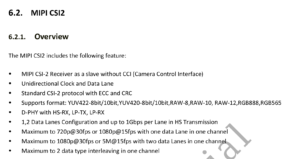 As part of an internship in 2020 and then a customer project, Bootlin intern Kévin L’Hôpital and Bootlin engineer Paul Kocialkowski worked on extending the Allwinnera camera interface support with support for MIPI CSI2 cameras. In fact, this addition was done to two Allwinner camera interface drivers: the sun6i driver which is used on Allwinner A31 and V3s/V3/S3, and the sun8i-a83t, which is used on the Allwinner A83T.
As part of an internship in 2020 and then a customer project, Bootlin intern Kévin L’Hôpital and Bootlin engineer Paul Kocialkowski worked on extending the Allwinnera camera interface support with support for MIPI CSI2 cameras. In fact, this addition was done to two Allwinner camera interface drivers: the sun6i driver which is used on Allwinner A31 and V3s/V3/S3, and the sun8i-a83t, which is used on the Allwinner A83T.
Through a fairly long 15 patches patch series, support for MIPI CSI2 is added to both camera interface controllers. We have tested both with Omnivision sensors, which are described below.
The series is currently in its third iteration, which was posted by Paul Kocialkowski on December 11, 2020 on the linux-media mailing list:
Paul Kocialkowski (15):
docs: phy: Add a part about PHY mode and submode
phy: Distinguish between Rx and Tx for MIPI D-PHY with submodes
phy: allwinner: phy-sun6i-mipi-dphy: Support D-PHY Rx mode for MIPI
CSI-2
media: sun6i-csi: Use common V4L2 format info for storage bpp
media: sun6i-csi: Only configure the interface data width for parallel
dt-bindings: media: sun6i-a31-csi: Add MIPI CSI-2 input port
media: sun6i-csi: Add support for MIPI CSI-2 bridge input
dt-bindings: media: Add A31 MIPI CSI-2 bindings documentation
media: sunxi: Add support for the A31 MIPI CSI-2 controller
ARM: dts: sun8i: v3s: Add nodes for MIPI CSI-2 support
MAINTAINERS: Add entry for the Allwinner A31 MIPI CSI-2 bridge
dt-bindings: media: Add A83T MIPI CSI-2 bindings documentation
media: sunxi: Add support for the A83T MIPI CSI-2 controller
ARM: dts: sun8i: a83t: Add MIPI CSI-2 controller node
MAINTAINERS: Add entry for the Allwinner A83T MIPI CSI-2 bridge
.../media/allwinner,sun6i-a31-csi.yaml | 88 ++-
.../media/allwinner,sun6i-a31-mipi-csi2.yaml | 149 ++++
.../media/allwinner,sun8i-a83t-mipi-csi2.yaml | 147 ++++
Documentation/driver-api/phy/phy.rst | 18 +
MAINTAINERS | 16 +
arch/arm/boot/dts/sun8i-a83t-bananapi-m3.dts | 2 +-
arch/arm/boot/dts/sun8i-a83t.dtsi | 26 +
arch/arm/boot/dts/sun8i-v3s.dtsi | 67 ++
drivers/media/platform/sunxi/Kconfig | 2 +
drivers/media/platform/sunxi/Makefile | 2 +
.../platform/sunxi/sun6i-csi/sun6i_csi.c | 165 +++--
.../platform/sunxi/sun6i-csi/sun6i_csi.h | 58 +-
.../platform/sunxi/sun6i-csi/sun6i_video.c | 53 +-
.../platform/sunxi/sun6i-csi/sun6i_video.h | 7 +-
.../platform/sunxi/sun6i-mipi-csi2/Kconfig | 12 +
.../platform/sunxi/sun6i-mipi-csi2/Makefile | 4 +
.../sunxi/sun6i-mipi-csi2/sun6i_mipi_csi2.c | 590 ++++++++++++++++
.../sunxi/sun6i-mipi-csi2/sun6i_mipi_csi2.h | 117 ++++
.../sunxi/sun8i-a83t-mipi-csi2/Kconfig | 11 +
.../sunxi/sun8i-a83t-mipi-csi2/Makefile | 4 +
.../sun8i-a83t-mipi-csi2/sun8i_a83t_dphy.c | 92 +++
.../sun8i-a83t-mipi-csi2/sun8i_a83t_dphy.h | 39 ++
.../sun8i_a83t_mipi_csi2.c | 657 ++++++++++++++++++
.../sun8i_a83t_mipi_csi2.h | 197 ++++++
drivers/phy/allwinner/phy-sun6i-mipi-dphy.c | 164 ++++-
drivers/staging/media/rkisp1/rkisp1-isp.c | 3 +-
include/linux/phy/phy-mipi-dphy.h | 13 +
27 files changed, 2581 insertions(+), 122 deletions(-)
create mode 100644 Documentation/devicetree/bindings/media/allwinner,sun6i-a31-mipi-csi2.yaml
create mode 100644 Documentation/devicetree/bindings/media/allwinner,sun8i-a83t-mipi-csi2.yaml
create mode 100644 drivers/media/platform/sunxi/sun6i-mipi-csi2/Kconfig
create mode 100644 drivers/media/platform/sunxi/sun6i-mipi-csi2/Makefile
create mode 100644 drivers/media/platform/sunxi/sun6i-mipi-csi2/sun6i_mipi_csi2.c
create mode 100644 drivers/media/platform/sunxi/sun6i-mipi-csi2/sun6i_mipi_csi2.h
create mode 100644 drivers/media/platform/sunxi/sun8i-a83t-mipi-csi2/Kconfig
create mode 100644 drivers/media/platform/sunxi/sun8i-a83t-mipi-csi2/Makefile
create mode 100644 drivers/media/platform/sunxi/sun8i-a83t-mipi-csi2/sun8i_a83t_dphy.c
create mode 100644 drivers/media/platform/sunxi/sun8i-a83t-mipi-csi2/sun8i_a83t_dphy.h
create mode 100644 drivers/media/platform/sunxi/sun8i-a83t-mipi-csi2/sun8i_a83t_mipi_csi2.c
create mode 100644 drivers/media/platform/sunxi/sun8i-a83t-mipi-csi2/sun8i_a83t_mipi_csi2.h
Here as well, the patch series has gone through a number of iterations, with significant reshaping to take into account the comments and feedback of other kernel developers and maintainers, so we hope to be near the point where it can be merged.
Omnivision OV8865 camera sensor driver
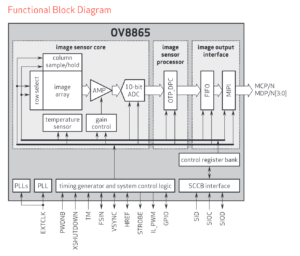 As part of his internship at Bootlin in 2020, Kévin L’Hôpital implemented a driver for the OV8865 camera sensor, connected over MIPI CSI2 to an Allwinner A83T platform. This OV8865 was then taken by Bootlin engineer Paul Kocialkowski, who did additional rework and polishing.
As part of his internship at Bootlin in 2020, Kévin L’Hôpital implemented a driver for the OV8865 camera sensor, connected over MIPI CSI2 to an Allwinner A83T platform. This OV8865 was then taken by Bootlin engineer Paul Kocialkowski, who did additional rework and polishing.
We are currently at the 4th iteration of this driver, which has been posted on December 11, 2020, and it has now been accepted and submitted to the V4L maintainer in a pull request.
Kévin L'hôpital (1): ARM: dts: sun8i: a83t: bananapi-m3: Enable MIPI CSI-2 with OV8865 Paul Kocialkowski (2): dt-bindings: media: i2c: Add OV8865 bindings documentation media: i2c: Add support for the OV8865 image sensor .../bindings/media/i2c/ovti,ov8865.yaml | 124 + arch/arm/boot/dts/sun8i-a83t-bananapi-m3.dts | 102 + drivers/media/i2c/Kconfig | 13 + drivers/media/i2c/Makefile | 1 + drivers/media/i2c/ov8865.c | 2981 +++++++++++++++++ 5 files changed, 3221 insertions(+) create mode 100644 Documentation/devicetree/bindings/media/i2c/ovti,ov8865.yaml create mode 100644 drivers/media/i2c/ov8865.c
Omnivision OV5648 camera sensor driver
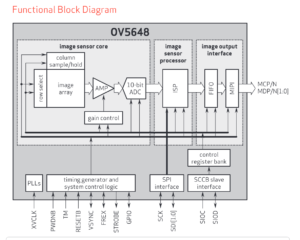 In addition to the work done by Bootlin intern Kévin L’Hôpital on OV8865 with Allwinner A83T, Paul Kocialkowski worked on OV5648 with Allwinner V3s, also connected over MIPI CSI2. This work results in a driver for the OV5648 camera sensor, which Paul has submitted to the linux-media mailing list.
In addition to the work done by Bootlin intern Kévin L’Hôpital on OV8865 with Allwinner A83T, Paul Kocialkowski worked on OV5648 with Allwinner V3s, also connected over MIPI CSI2. This work results in a driver for the OV5648 camera sensor, which Paul has submitted to the linux-media mailing list.
This driver is now in is 5th iteration, posted on December 11, 2020, and it has now been accepted and submitted to the V4L maintainer in a pull request.
Paul Kocialkowski (2): dt-bindings: media: i2c: Add OV5648 bindings documentation media: i2c: Add support for the OV5648 image sensor .../bindings/media/i2c/ovti,ov5648.yaml | 115 + drivers/media/i2c/Kconfig | 13 + drivers/media/i2c/Makefile | 1 + drivers/media/i2c/ov5648.c | 2638 +++++++++++++++++ 4 files changed, 2767 insertions(+) create mode 100644 Documentation/devicetree/bindings/media/i2c/ovti,ov5648.yaml create mode 100644 drivers/media/i2c/ov5648.c
TW9900 PAL/NTSC video decoder driver
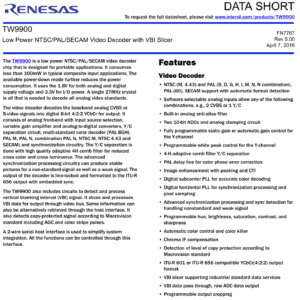 In addition to working on the Rockchip camera interface driver, Maxime Chevallier has also worked on a driver for the TW9900 PAL/NTSC video decoder. This chip from Renesas, takes as input an analog PAL or NTSC signal, digitizes it and outputs it on a parallel BT656 interface, which in our case was connected to a Rockchip PX30 platform.
In addition to working on the Rockchip camera interface driver, Maxime Chevallier has also worked on a driver for the TW9900 PAL/NTSC video decoder. This chip from Renesas, takes as input an analog PAL or NTSC signal, digitizes it and outputs it on a parallel BT656 interface, which in our case was connected to a Rockchip PX30 platform.
Maxime posted the third iteration of the patch series adding this driver on December 22, 2020 on the linux-media mailing list.
Maxime Chevallier (3): dt-bindings: vendor-prefixes: Add techwell vendor prefix media: dt-bindings: media: i2c: Add bindings for TW9900 media: i2c: Introduce a driver for the Techwell TW9900 decoder .../devicetree/bindings/media/i2c/tw9900.yaml | 60 ++ .../devicetree/bindings/vendor-prefixes.yaml | 2 + MAINTAINERS | 6 + drivers/media/i2c/Kconfig | 11 + drivers/media/i2c/Makefile | 1 + drivers/media/i2c/tw9900.c | 617 ++++++++++++++++++ 6 files changed, 697 insertions(+) create mode 100644 Documentation/devicetree/bindings/media/i2c/tw9900.yaml create mode 100644 drivers/media/i2c/tw9900.c
Rockchip HW-accelerated H264 video encoding
In 2018 and thanks to success of the crowd-funding campaign we ran back then, Bootlin engineer Paul Kocialkowski pioneered support for stateless video decoders in the Linux kernel, with a first driver supporting MPEG2, H264 and H265 HW-accelerated video decoding on Allwinner platforms.
 In 2020, Paul was tasked to work on HW-accelerated H264 video encoding for Rockchip platforms, which also use a stateless video encoder. Of course, Paul took the same approach of going towards an upstream-acceptable solution rather than relying on out-of-tree and vendor-specific solutions provided by Rockchip.
In 2020, Paul was tasked to work on HW-accelerated H264 video encoding for Rockchip platforms, which also use a stateless video encoder. Of course, Paul took the same approach of going towards an upstream-acceptable solution rather than relying on out-of-tree and vendor-specific solutions provided by Rockchip.
Paul has been able to implement a working solution for one of our customers, and while the result is not yet in a shape where it can be submitted upstream, Paul has presented its result at the Embedded Linux Conference Europe 2020: the slides and video. The kernel code is available at https://github.com/bootlin/linux/tree/hantro/h264-encoding while the user-space code is available at https://github.com/bootlin/v4l2-hantro-h264-encoder.
As explained in Paul’s talk, this is not fully ready for upstream, as lots of discussions are needed on the user-space APIs, especially around the topic of rate control.
If you are interested in having this work fully available in the upstream Linux kernel, please contact us. We are looking for additional funding and support to push this completely upstream.
Conclusion
As can be seen from the numerous topics covered in this blog post, Bootlin has significant experience with the Video4Linux subsystem, and is able to both implement support for new hardware, extend the Video4Linux subsystem if needed, and contribute drivers and changes to the official Linux kernel.



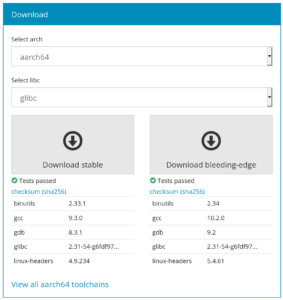
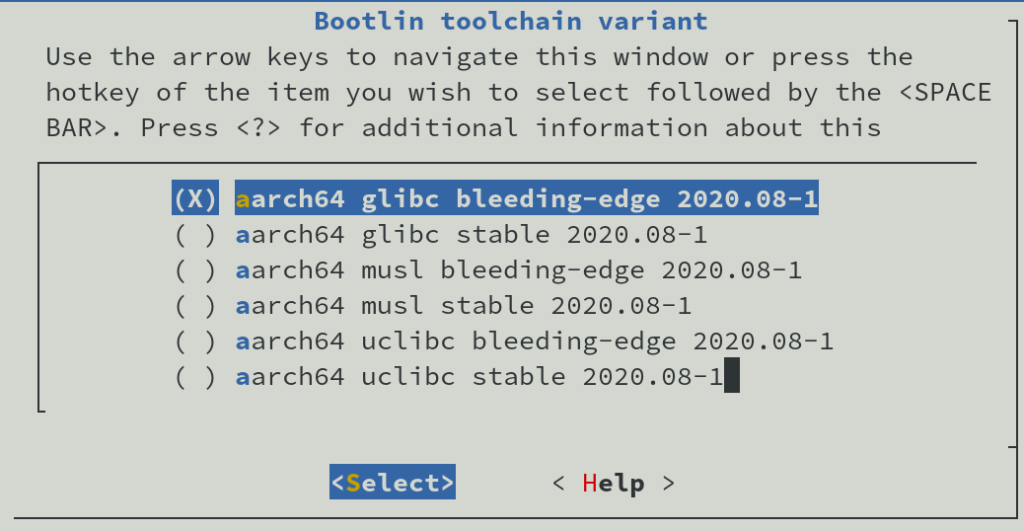
 The
The 